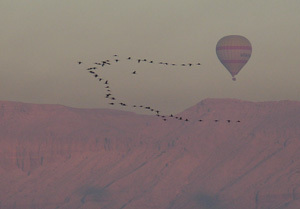Our First Full Week
Excavation got underway last Saturday (our work week is Saturday-Thursday), with teams working in Temple A, at the structures north of the Mut Temple’s First Pylon, and in the Taharqa Gate. The restoration of Chapel D is also making rapid progress. Let’s have a look at the week’s work, starting from the east in Temple A.
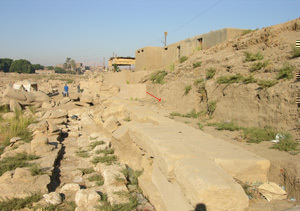

On the left you are looking west along the north side of Temple A’s Forecourt at the start of the season. The arrow shows the spot where we found the decorated lintel last year, leaning against the precinct’s mud brick enclosure wall. The space between the enclosure wall and the sandstone north wall of the court was completely filled with earth and, in fact, seems to have had a plastered floor that probably dates to the Roman Period. This year we want to find out what lies below this level.
It’s not going to be as easy as we had hoped, as you may be able to see from the photo on the right. Rather than a corridor running the length of the Forecourt behind the stone wall, we have a mass of mud brick at the east end (right of photo) that blocks the space. West of it, the area has been robbed out and only a trace of the plaster floor, sloping down to the east, is visible against the remains of the face of the enclosure wall. How do the mass of the brick and the enclosure relate to each other?
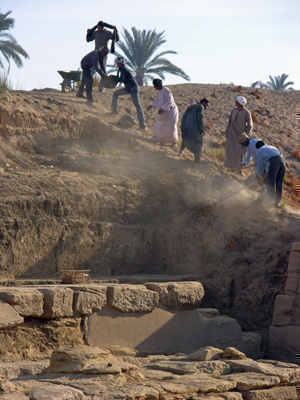
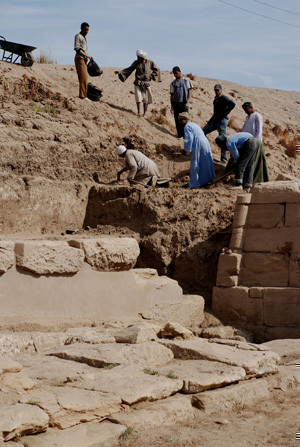
After puzzling over the area for some days, we decided on Thursday that since the brick mass seems to continue into the mound of debris to the south, our only hope of figuring out the problem is to clear the area between the 2nd Pylon and the enclosure wall – not an easy task given the steep slope of the area. By noon (right) the mud brick of the enclosure wall had begun to emerge.
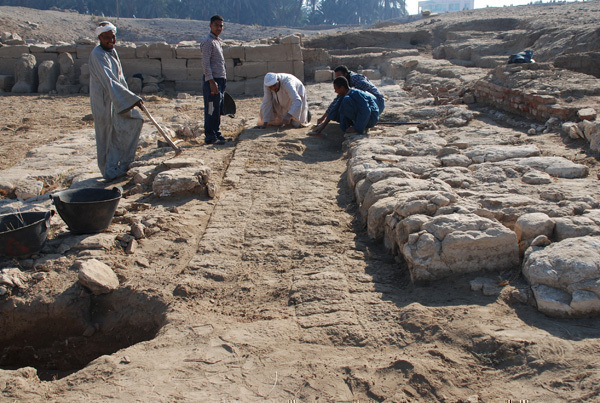
On the south side of the Forecourt, Qufti Abdel Aziz has spent the week defining the outlines of the various mud brick walls in the area so that William Peck, Associate Director of the expedition and our draughtsman, can begin drawing them when he arrives next week. This is painstaking work as it is often hard to distinguish between mud brick, especially damaged mud brick, and the surrounding soil.
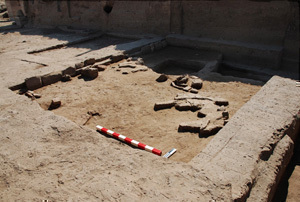
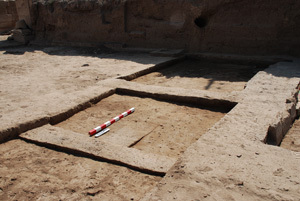
We got back to the rooms north of the Mut Temple’s First Pylon this week as well. At the end of the last season, we uncovered an unexpected stone footing (upper left) to the east wall of the largest room in the area and traces of what looked like a hard lime plaster on the floor. So that’s where we started this year. As you can see in this view to the southeast, the plaster is mainly concentrated on the west side of the room, with a few pieces near the pit in the room’s center. When we removed the pieces it became obvious that they are not the remains of a simple plaster wall as they are very thick (as much as 2 inches) and have clearly been shaped. We’ve kept the pieces and will study them further. Under them we found a level of mud brick that fills at least the northern half of the room.
Since we need to let the bricks here dry out for a few days to make them easier to define, we moved east to the smaller room next to the large room and to the area just north of it. This area, shown in the photo on the right, was already defined by a wall running north from the northeast corner of the smaller room and the east wall of the larger room. We immediately uncovered another wall linking the walls just mentioned; it runs across the lower portion of the photo. It is not clear if the row of brick to the right of the meter stick extends the full length of this new room. We have yet to determine how these various walls fit together.
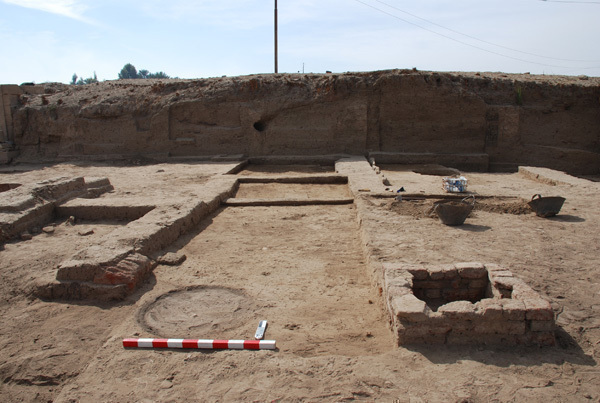
These bricks, too, were left to dry and we moved further north, where we found an ash-lined circle that was probably an oven (on the right side of the photo, behind meter stick). This photo shows the whole area, with new and old walls and ash circle, towards the end of the workday on Thursday.
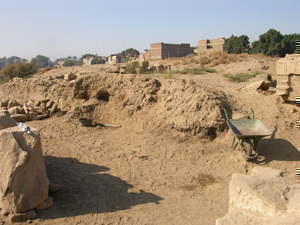
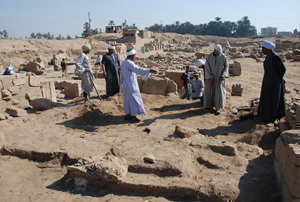
The Taharqa Gate was discovered and partially excavated in 1977. This year we hope to finish clearing it and at least begin restoring what remains. On the left is a view of the east side of the gate at the start of work. On the right, workmen, supervised by Qufti Abdullah, begin to uncover mud brick walls and fallen blocks of stone within the gate.
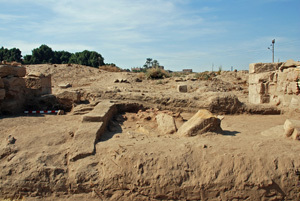
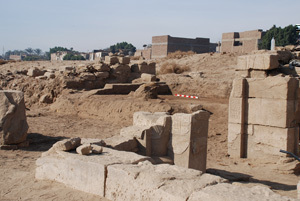
By midweek, as you can see in the photo on the left, we had clearly defined a mud brick wall running across the whole gateway from the south to the north jamb, with another mud brick wall dividing the space into two rooms. At the east end of the area (foreground) are a number of blocks fallen (or removed) from the gateway. The photo on the right, taken at the end of work on Thursday, shows both the relation between Chapel D and the Taharqa Gateway and the progress we have made in the Gate.

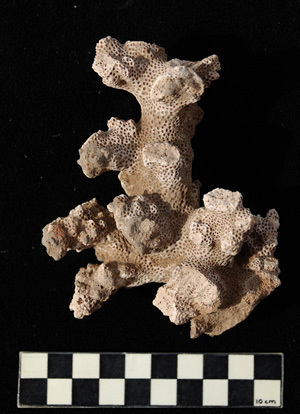
Out of the Taharqa Gate this week have come our two most interesting finds so far. On the left is a clay seal impression from a roll of papyrus; unfortunately we don’t have the papyrus itself. When a papyrus was rolled up, the owner would take a piece of moist clay, apply it to the binding of the papyrus and stamp it with an identifying seal, in this case a decorative double-knot rather than a name. Below the seal impression you can see the fingerprint of the person who applied the clay.
On the right, our oddest find in years: a large piece of coral discovered in the southeast corner of the gate’s southern room. It has not been shaped but is in its natural form. What it is doing so far from either the Red Sea or the Mediterranean we don’t know, although we do know that to the Egyptians coral had magical properties.
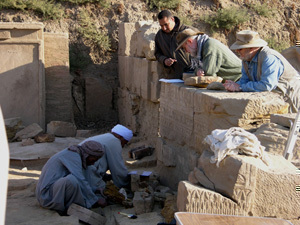
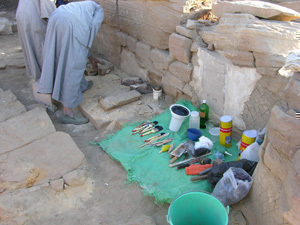
Work proceeds apace in Chapel D. On the left, Richard, Jaap and our inspector, Osama, take a look at the work. On the right, a mobile conservation lab, Mut-style.
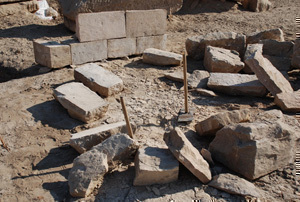
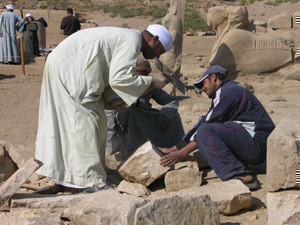
The new blocks for Chapel D are prepared on site. From the pile of rough blocks (purchased from a quarry), a block is chosen and one side is dressed (left photo). The dimensions of the finished block are marked on the smoothed face (center, left photo) and the mason then cuts the block to the proper size by hand (right photo). In the background of the photo on the left is a group of finished blocks.
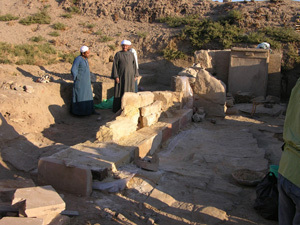
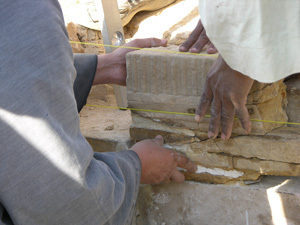
The new foundations for the inner face of the west wall were finished earlier this week (left) and on Thursday came the big moment: putting the first of the conserved blocks back in place. The positioning has to be absolutely accurate or the rest of the blocks won’t fit properly.
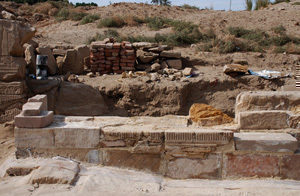

And here is how things looked at the end of the work on Thursday. The first course of the interior face is in place (left). While the work on the interior of the room has been going on, the exterior wall has also been treated. Its foundations had rotted away in places, so it, too, was dismantled, new foundations were created, and the wall reassembled.
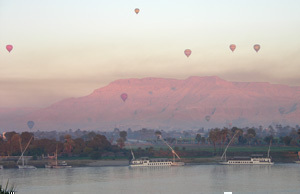
Getting up before dawn has its compensations. Watching balloons rise over the Theban mountains at sunrise is always special. Add a flock of migrating ibises on a misty morning and you have pure magic. Thank you, Jaap, for this photo.
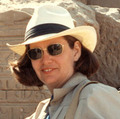
Mary McKercher holds a BA in Ancient Near Eastern Studies (specializing in Egypt) from the University of Toronto and is also a trained archaeologist. In 1979 she joined the Brooklyn Museum’s expedition to the Precinct of the Goddess Mut at South Karnak as photographer and archaeologist, roles she continues to fill. She has contributed to the Mut Expedition’s “Dig Diary” since it began in 2005, and put together the photographs for the 8 Mut Expedition photo sets on the museum’s Flickr site. With her husband, Richard Fazzini, she has also researched and written about the West’s ongoing fascination with ancient Egypt, commonly known as Egyptomania.

